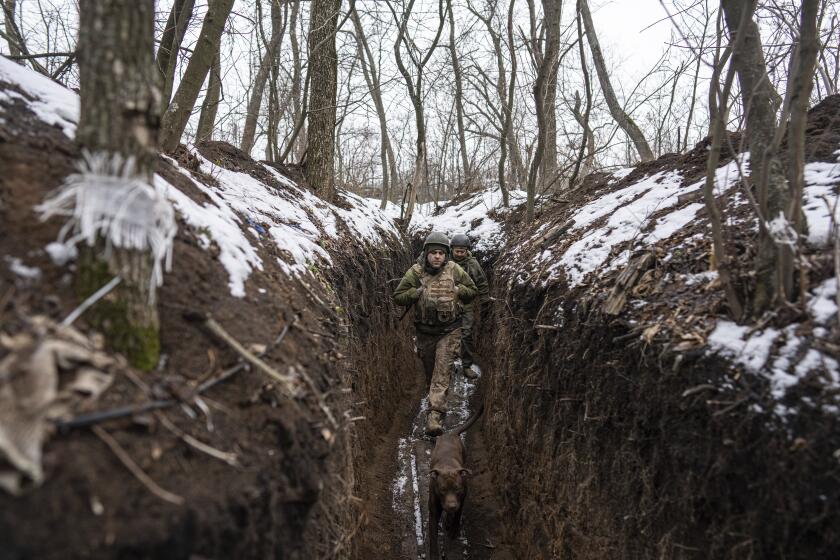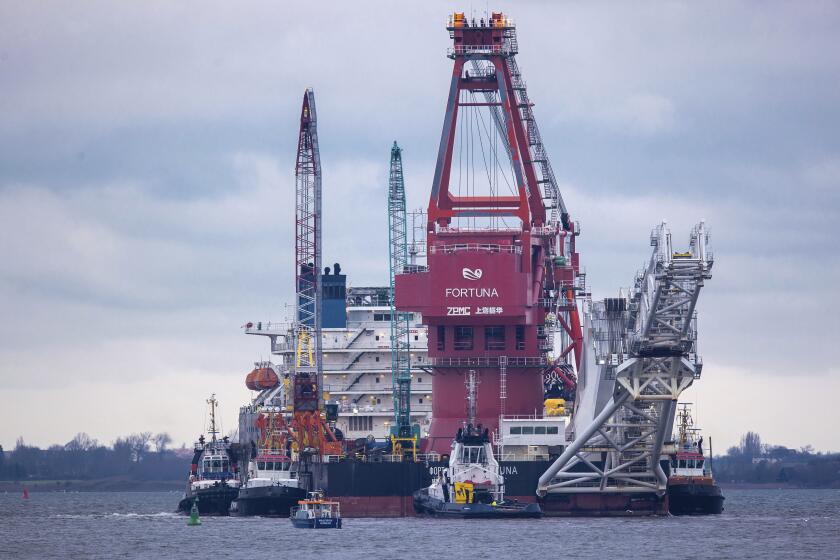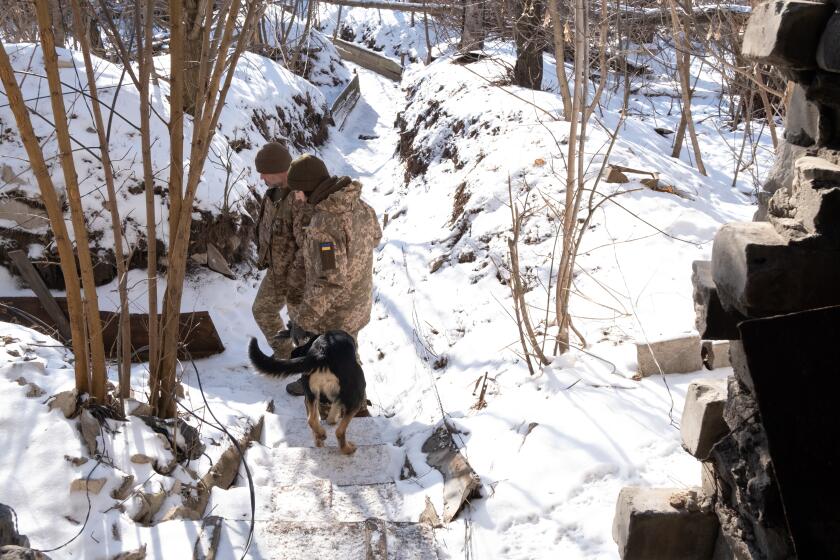Putin’s Ukraine strategy is a mix of threats and diplomacy. Will it work?

- Share via
MOSCOW — With Russia carrying out a massive military buildup near Ukraine and the West roundly rejecting Moscow’s security demands, the window for diplomacy in the crisis appears to be closing.
But even as Moscow continues to bolster its forces and holds sweeping war games, Russian President Vladimir Putin says he is open to more negotiations in what appears to be a calculated game of brinkmanship intended to persuade Washington and its allies to accept Russia’s demands.
The West fears that a Russian invasion of Ukraine may be imminent, while Russia maintains that it has no plans to invade but wants its security concerns addressed.
Here is a look at the Kremlin’s strategy in the standoff:
Demands and responses
Russia wants the U.S. and its allies to keep Ukraine and other former Soviet nations from joining NATO, refrain from putting any weapons near Russia and roll back alliance forces from Eastern Europe.
Washington and NATO reject those demands as nonstarters, but they also are offering to discuss possible limits on missile deployments, a greater transparency of military drills and other confidence-building measures.
Putin has yet to deliver Moscow’s formal response to the Western proposals, but he has already described them as secondary and warned that he would not take “no” for an answer to his main demands. He countered the Western argument about NATO having an open-door policy by arguing that it threatens Russia and violates the principle of the “indivisibility of security” enshrined in international agreements.
With Russian troops just miles away, the residents of a small Ukrainian village wonder if a possible invasion has its sights set on them.
Military muscle-flexing
With the West rejecting its key demands, the Kremlin has raised the stakes by massing more than 100,000 troops near Ukraine and carrying out a series of military maneuvers from the Arctic Ocean to the Black Sea.
As part of the show of force, Moscow has moved trainloads of troops, tanks and weapons from the Far East and Siberia to Belarus for joint war games, drawing Western concerns that Russia could use them as a cover for an invasion.
Washington and its allies are raising the prospect of unprecedented sanctions in the event of an invasion, including a possible ban on dollar transactions, draconian restrictions on key technology imports such as microchips and the shutdown of a newly built Russian gas pipeline to Germany.
President Biden’s administration also has deployed additional U.S. troops to Poland, Romania and Germany in a show of Washington’s commitment to protect NATO’s eastern flank. The U.S. and its allies have delivered planeloads of weapons and munitions to Ukraine.
Calculated escalation
By concentrating troops that could attack Ukraine from many directions, Putin has demonstrated a readiness to escalate the crisis to achieve his goals.
“Putin appears overconfident and is exhibiting a high level of risk-tolerance,” said Ben Hodges, who served as commanding general of the U.S. Army Europe and now works at the Center for European Policy Analysis. “He seems intent on applying maximum pressure on the West in this self-manufactured crisis, in hopes that Ukraine or NATO will eventually make concessions.”
President Biden has targeted Russia’s Nord Stream 2 natural gas pipeline as he tries to deter the Kremlin from a potential invasion of Ukraine.
Some observers expect Putin to further ratchet up tensions by expanding the scope and area of the military drills.
Fyodor Lukyanov, who is head of the Moscow-based Council for Foreign and Defense Policies and who closely follows the Kremlin’s thinking, predicted that a Western refusal to discuss Russia’s main demands would trigger a new round of escalation.
“Logically, Russia will need to raise the level of tensions,” Lukyanov said. “If the goals set are not being achieved, then you need to increase pressure — first of all through a demonstration of force.”
Lukyanov said that while invading Ukraine is not what Putin wants, he may challenge the West by other means.
“The whole idea as envisaged by Putin ... was not to solve the Ukrainian crisis by means of war, but to bring the West to the negotiations table about principles of European security arrangements,” Lukyanov noted. “The moment Russia starts a war against Ukraine, the whole previous game will be over and the new game will happen at an absolutely different level of risk. And all we know about Mr. Putin is that he is not a gambler. He is a calculated player.”
Potential paths for compromise
While Putin and his officials have insisted they expect the U.S. and NATO to bow to Russia’s demands — a prospect that looks all but impossible — some Kremlin-watchers expect Moscow to eventually accept a compromise that would help avoid hostilities and allow all sides to save face.
Even though Western allies won’t renounce NATO’s open-door policy, they have no intention to embrace Ukraine or any other ex-Soviet nation anytime soon. Some analysts floated an idea of a potential moratorium on expanding the alliance.
Slog of trench warfare in eastern Ukraine yields scenes reminiscent of World War I.
Gwendolyn Sasse, a Carnegie Europe fellow who heads the Centre for East European and International Studies in Berlin, voiced skepticism, saying that “the worst would be to signal that there are divisions in NATO,” noting that Putin might not be satisfied with it either.
Another possibility is the “Finlandization” of Ukraine, meaning that the country would acquire a neutral status, the way Finland did after World War II. The policy helped it maintain friendly ties with the Soviet Union throughout the Cold War.
Such a move would represent a sharp revision of Kyiv’s course toward NATO membership and likely fuel strong domestic criticism, but the Ukrainian public could eventually welcome the policy twist as a lesser evil, compared with a Russian invasion.
Asked about the “Finlandization” idea, French President Emmanuel Macron told reporters Monday that “this is one of the models on the table,” but he backtracked the next day when he visited Kyiv.
Another potential compromise would likely include steps to defuse tensions in eastern Ukraine, which has been controlled by Russia-backed separatists since a rebellion flared up there in 2014 shortly after Moscow’s annexation of Ukraine’s Crimean peninsula.
Breaking News
Get breaking news, investigations, analysis and more signature journalism from the Los Angeles Times in your inbox.
You may occasionally receive promotional content from the Los Angeles Times.
Russia has urged the West to press Ukraine to fulfill its obligations under a 2015 peace deal that was brokered by France and Germany and required Kyiv to offer self-rule to the rebel-held territories. The deal has been seen by Ukrainians as a betrayal of the country’s national interests, and its implementation has stalled.
Macron this week described the agreement as “the only path allowing to build peace ... and find a sustainable political solution.”
More to Read
Sign up for Essential California
The most important California stories and recommendations in your inbox every morning.
You may occasionally receive promotional content from the Los Angeles Times.
















